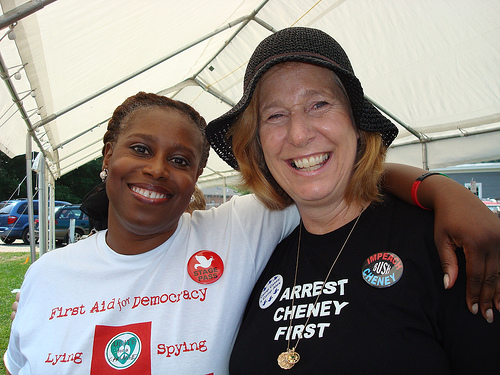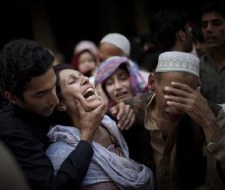Combating Somali Piracy: How Many People Can We Afford To Kill?
 Wednesday, April 15, 2009 at 18:12
Wednesday, April 15, 2009 at 18:12  “Now and then we had a hope that if we lived and were good, God would permit us to be pirates” – Mark Twain
“Now and then we had a hope that if we lived and were good, God would permit us to be pirates” – Mark TwainYou don’t have to be a serious news junkie to know that there is currently a lively debate ongoing in the media on the issue of combating Somali pirates in the Gulf of Aden. Commentators from across the political spectrum have laid out countless detailed plans for fighting the pirates both at sea and on land, and some such as CNN’s Jack Cafferty and Rick Sanchez have even put the question directly to their audiences. However, all of the solutions presented seem to involve some level of military force used against Somalia, specifically US military force, and the major differences between the plans are over questions of financial cost and political willpower. To put it bluntly, the real question at hand is how many Somali people we really feel like killing right now.
But why do we insist on making this debate so narrow and yet still complicated when it doesn’t have to be either? Unlike the conventional wisdom of US military violence and nation building, which has an atrocious rate of success, there is a myriad of solutions available which have not yet even been attempted with Somalia, yet are far more likely to produce the desired long-term stability. Given the huge challenges facing the United States from its two ongoing wars in Iraq and Afghanistan and the global financial crisis, isn’t it time we explored some of these other options?
 The conventional wisdom is very simple. While they all agree that the Navy SEAL snipers killing the pirates was really cool, the generally liberal, realist, soft power crowd is pushing for an increased naval presence, that is ships with weapons, in the Gulf of Aden, the hawkish, bold-faced imperialist folks are asking for air strikes and special forces strikes against pirate sanctuaries in Somalia, and the population at large is especially craven, calling for public hangings of pirates and shoot-on-sight rules of engagement for US Navy ships in the region. Typically when presented by experts and commentators, these plans will also feature a data set debunking the other side’s plan, which means that when put side by side, they cancel each other out with no shortage of irony.
The conventional wisdom is very simple. While they all agree that the Navy SEAL snipers killing the pirates was really cool, the generally liberal, realist, soft power crowd is pushing for an increased naval presence, that is ships with weapons, in the Gulf of Aden, the hawkish, bold-faced imperialist folks are asking for air strikes and special forces strikes against pirate sanctuaries in Somalia, and the population at large is especially craven, calling for public hangings of pirates and shoot-on-sight rules of engagement for US Navy ships in the region. Typically when presented by experts and commentators, these plans will also feature a data set debunking the other side’s plan, which means that when put side by side, they cancel each other out with no shortage of irony.The consequences of these plans are also simple. The end result of all of them, no matter whether they succeed or fail, is that the US is going to kill a lot of Somalis. None of the plans even attempt to address the root causes of piracy in the gulf, like hellish poverty, illegal over-pollution, and the absence of basic human services in Somalia. So in order for these options to succeed, you’d have to believe that these desperate, armed-to-the-teeth gangsters from an apocalyptic-level failed state will be so incensed at the sight of a dead body that they’ll permanently abstain from the only profession that brings their family any shred of dignity and sustenance. Amazing logic, right? If you knew how much people were paid to come up with ideas like that, your head would explode.
But there are other options available. Rather than falling back on the usual tool of military violence, they instead focus on the seeds of instability and piracy in Somalia.
Seemingly the most obvious idea would be to ask the Somalis themselves what to do about piracy. Are they asking for food, money and an end to illegal toxic waste dumping in their fishing grounds? Or are they asking for 200lb JDAMs to be dropped on their villages? You could ask even the most destitute, illiterate among them, and I’m sure they’d have an opinion either way. However, I’ve yet to see one actual Somali in the mainstream discussion, it’s mostly the usual suspects in the media foreign policy elite whose opinions are deemed worthy of consideration. At the very least they could lay out a clear, concrete set of grievances to be acknowledged in whatever response the US eventually chooses.
 Instead of special forces, why not deploy diplomats to Somalia? The European Union would be the most desirable, as the catastrophic circumstances of Somalia would require the most skilled negotiators available. Director of the Global Governance Initiative Parag Khanna writes of their prowess, “Charlemagne’s efforts to resurrect the Roman Empire have been succeeded, over a millennium later, by the multipronged armadas of Brussels Eurocrats steadily colonizing Europe’s periphery, in the Baltics, the Balkans, and, eventually, Anatolia and the Caucasus. The Eurocrats’ book is not the Bible but rather the acquis communautaire: the 31 chapters of the Lex Europea, which is rebuilding EU member states from the inside out.” Great, if they can do all that, why couldn’t they handle building a state in Somalia?
Instead of special forces, why not deploy diplomats to Somalia? The European Union would be the most desirable, as the catastrophic circumstances of Somalia would require the most skilled negotiators available. Director of the Global Governance Initiative Parag Khanna writes of their prowess, “Charlemagne’s efforts to resurrect the Roman Empire have been succeeded, over a millennium later, by the multipronged armadas of Brussels Eurocrats steadily colonizing Europe’s periphery, in the Baltics, the Balkans, and, eventually, Anatolia and the Caucasus. The Eurocrats’ book is not the Bible but rather the acquis communautaire: the 31 chapters of the Lex Europea, which is rebuilding EU member states from the inside out.” Great, if they can do all that, why couldn’t they handle building a state in Somalia?Provided they are dispatched with the same resources and support as their military counterparts are, these diplomats could succeed in laying some framework for a sovereign Somali government. Aid agencies and other NGO’s have shown they are capable of operating in extremely hostile environments with only a hint of a functioning state, such as Rwanda and Sudan. It’s possible that a skilled diplomatic mission could assist the Somalis in creating enough of a foundation of statehood for these aid agencies to join with humanitarian assistance.
 However, the idea of using a European solution to an American foreign policy problem is almost unthinkable, and multilateral coalitions are, at best, frowned upon. That doesn’t mean the US only has to use its military might though. It has other powerful, untapped resources at its disposal. Namely, the massive organized Peace Movement.
However, the idea of using a European solution to an American foreign policy problem is almost unthinkable, and multilateral coalitions are, at best, frowned upon. That doesn’t mean the US only has to use its military might though. It has other powerful, untapped resources at its disposal. Namely, the massive organized Peace Movement.The Peace movement, as with any organized political movement, comes complete with its own elite policy wonks, its own intelligentsia, and even its own media and social systems with which to organize and direct broad and diverse groups of people. The American Peace Movement also has the added benefit of never being allowed into mainstream political debate, and is therefore free of the corrupt hypocrisy and institutional apathy that typifies other foreign policy sects. Likewise, it also means that they’re not currently tied up with other issues like Iraq and Afghanistan like the rest of the foreign policy elite.
The price of utilizing American peace activists would be dramatically less than any of the other options currently up for debate. While the cost of US military power is in the trillions, and even skilled EU bureaucrats can charge exorbitant salaries, peace activists have shown they are capable of operating highly effectively with little to no funding available. Given a small amount of funding and protection, the results they could achieve in Somalia might be quite groundbreaking. Perhaps its time to constructively engage them in the task of stabilizing Somalia. They may have some very interesting ideas particularly as it concerns mobilizing Somali citizens into a coherent bloc capable of projecting statehood.
Of course these options are very vague and untested, nowhere near as precise as the options laid out in the mainstream debate. Some might even find it absurd or ridiculous to suggest dispatching a phalanx of European diplomats or appointing Cindy Sheehan as Special Envoy to Somalia, but my point is only to show that there may be other options worth exploring and debating besides the standard military response.




